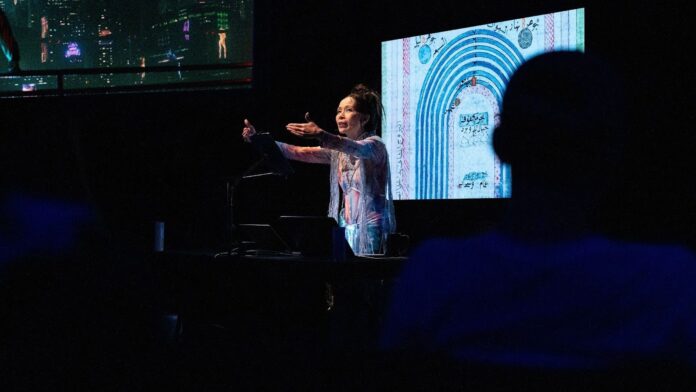On Oct. 24, the multimedia performance lecture explored the portrayal of Asian culture and presence of Asian individuals in science fiction
By JESSICA YUNG — campus@theaggie.org
On Oct. 24, the Mondavi Center hosted a multimedia performance lecture of Astria Suparak’s “Asian futures, without Asians” in Vanderhoef Studio Theatre from 7:30 to 9:30 p.m. The performance demonstrated the prevalence of Asian themes in science fiction without the presence of Asian individuals.
Suparak is an Oakland-based artist and curator, according to the bio on her website.
“Her cross-disciplinary projects address complex and urgent issues (like institutionalized racism, feminisms and colonialism) made accessible through a popular culture lens, such as science fiction movies, rock music and sports,” her website reads.
The program was sponsored by UC Davis Asian American Studies, Mellon Foundation Affirming Multivocal Humanities Grant and the Mondavi Center for the Performing Arts. Suparak’s lecture examined films and TV shows such as “Firefly,” “Star Wars,” “Ghost in the Shell,” “Doctor Strange” and “Black Mirror.”
There are certain tropes that science fiction typically uses and certain Asian aesthetics are used over others and presented in a different light. For example, the Chinese food stall in “Firefly” (2002) is seen as being dirty, but the use of Japanese tea sets is seen as being high class in the same show.
Suparak explained this concept in her performance.
“All food in China is cheap [and] working class,” Suparak said. “Japanese food is high end, [which] makes zero sense.”
The Mondavi Center’s website further elaborates on the repercussions of this bias.
“Asian cultures have been mixed and matched, contrasted against and conflated with each other, often creating a fungible ‘Asianness’ in futuristic sci-fi,” the website reads.
Aneka Torgrimson, a second-year Asian American studies and political science double major and Asian American studies peer advisor, explained this misconception as presented by Suparak.
“[Suparak] not only highlighted the historical and spiritual significance of the Asian elements scattered across sci-fi worlds but also explored how they contribute to the ongoing erasure of Asian bodies from the genre while keeping their cultural aesthetics,” Torgrimson said. “She touched on concepts like ‘Commodity Orientalism,’ or the way objects and cultural markers from Asia are exploited as symbols of wealth and global exchange, and ‘Techno-Orientalism,’ which racializes Asia as both a producer and symbol of futuristic technology.”
In a statement following the results of the presidential election, Suparak said that her performance has taken new meaning.
“My focus on the histories and consequences of anti-immigrant, anti-Asian and anti-Arab rhetoric, visual culture and legislation in “Asian futures, without Asians” feels even more urgent in light of Trump’s reelection, with his promises to mass-deport immigrants and his decades-long targeting of people of color,” Suparak said.
Additionally, the event included a 15-minute intermission with electronic music performed by Tammy Lakkis.
“[Lakkis is a] songwriter, singer, producer, poet and DJ,” the event’s program read. “Lakkis made a name for herself performing playful, all hardware live sets and singing bilingually in English and Arabic.”
This was followed by a conversation between Suparak and Mark Jerng, the chair of African American Studies and a professor of English and Asian American Studies.
Jerng asked questions around topics that were discussed in Suparak’s lecture, such as the durability of Asian aesthetic tropes within the media.
“There are artists and writers doing work that is reimagining and resetting the entire set of tropes,” Suparak said.
Christy Vong, a fourth-year Asian American studies and community and regional development double major, said she was moved by Suparak’s performance.
“My perceptions about science fiction have definitely changed since the performance,” Vong said. “I think I’m more able to be critical of them now. Once she pointed it out, I can’t unsee the way there are backgrounds of Asian culture yet the main characters on screen are white people. I wish more white people could watch and listen to this performance. People studying abroad in Asia or involved with Asian culture somehow, I think would be a great audience to have. Because I feel these ideas are in peoples’ subconscious.”
Torgrimson expressed her thoughts about the impact of Suparak’s lecture.
“Suparak’s performance brought these issues to the forefront in a way that was both engaging and accessible, using sound and lighting to make the experience immersive,” Torgrimson said. “I appreciated how it opened space for deeper conversations about the genre’s cultural implications, making me think critically about how sci-fi can both inspire and exclude.”
Written by: Jessica Yung – campus@theaggie.org





